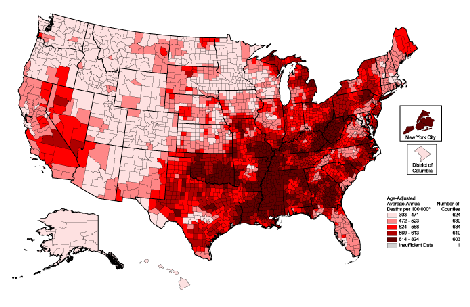|

|

|
Heart Disease Death Rates, 1996–2000
Adults Ages 35 Years and Older, by County

 Click
HERE to view a larger version
of this map. Click
HERE to view a larger version
of this map.
Learn more about
PDFs
*Heart disease death rates are
spatially smoothed to enhance the stability of rates in counties with small
populations. Deaths are defined according to the following
International Classification of Diseases (ICD) codes: ICD-9:
390–398, 402, 404–429; ICD-10: 100–109, I11, I13, 120–151.
Data
Sources: National Vital Statistics System, CDC, and the U.S. Census Bureau.
Heart Disease Facts
- Heart disease is the leading cause of death for
both women and men in the United States.*
- In 2001, 700,142 people died of heart disease (52% of them
women), accounting for 29% of all U.S. deaths. The age–adjusted death rate
was 246 per 100,000 population.†
- Heart disease is the leading cause of death for American Indians and
Alaska Natives, blacks, Hispanics, and whites. Although cancer is the
leading cause of death for Asians and Pacific Islanders (accounting for
26.4% of all deaths), heart disease is a close second (25.4%).†
- Heart disease death rates per 100,000 population for the five largest
U.S. racial/ethnic groups are as follows: Hispanics, 73; Asians and
Pacific Islanders, 77; American Indians, 79; blacks, 210; and whites, 263.†
- In 2004, heart disease is projected to cost $238.6 billion, including
health care services, medications, and lost productivity.§
- Studies among people with heart disease have shown that lowering high
blood cholesterol and high blood pressure can reduce the risk of dying of
heart disease, having a nonfatal heart attack, and needing heart bypass
surgery or angioplasty.
- Studies among people without heart disease have shown that lowering high
blood cholesterol and high blood pressure can reduce the risk of
developing heart disease.
___________________________________
* For this fact sheet, the term "heart disease"
refers to the broadest category of "diseases of the heart" as defined by the International
Classification of Diseases and used by CDC's National Center for Health Statistics. This category
includes acute rheumatic fever, chronic rheumatic heart disease, hypertensive heart disease,
coronary heart disease, pulmonary heart disease, congestive heart failure, and any other heart
condition or disease.
† Deaths: Leading Causes for 2001. National Vital
Statistics Reports 2003;52(9).
§ Heart Disease and Stroke Statistics—2004 Update. American
Heart Association; 2003.
CDC Activities to Reduce the Burden of Heart Disease
CDC’s Heart Disease
and Stroke Prevention Program
CDC currently funds health departments in 32 states and the District
of Columbia to develop, implement, and evaluate programs that promote
heart–healthy and stroke–free communities; prevent and control heart
disease, stroke, and their risk factors; and eliminate disparities among
populations. These programs emphasize the
use of education, policies, environmental strategies, and systems changes
to address heart disease and stroke in various settings and to ensure
quality of care. For more information, visit www.cdc.gov/cvh/state_program/index.htm.
Women and Heart Disease: An Atlas of Racial and Ethnic
Disparities in Mortality and Men and Heart Disease: An Atlas of
Racial and Ethnic Disparities in Mortality
These two publications present an extensive series of national and state
maps depicting disparities in county-level heart disease death rates among
the five largest U.S. racial and ethnic groups. This information can help
health professionals and concerned citizens tailor prevention policies and
programs to communities with the highest death rates for heart disease.
Interactive versions of the atlases are available at
http://www.cdc.gov/cvh/maps/.
For More Information
For more information
on heart disease, visit the following Web sites.
CDC's Cardiovascular Health Program
http://www.cdc.gov/cvh
American Heart
Association
http://www.americanheart.org*
National Heart, Lung, and Blood Institute
http://www.nhlbi.nih.gov
Download Fact Sheet
 This document
is available in Portable Document Format (PDF). Learn
more about PDFs. This document
is available in Portable Document Format (PDF). Learn
more about PDFs.
Heart Disease Fact Sheet (PDF –
1131k)
Return to Top of Page
*Links to non-Federal organizations are provided solely as a service to our users. Links do not constitute an endorsement of any organization by CDC or the Federal Government, and none should be inferred. The CDC is not responsible for the content of the individual organization Web pages found at this link.
|

|


